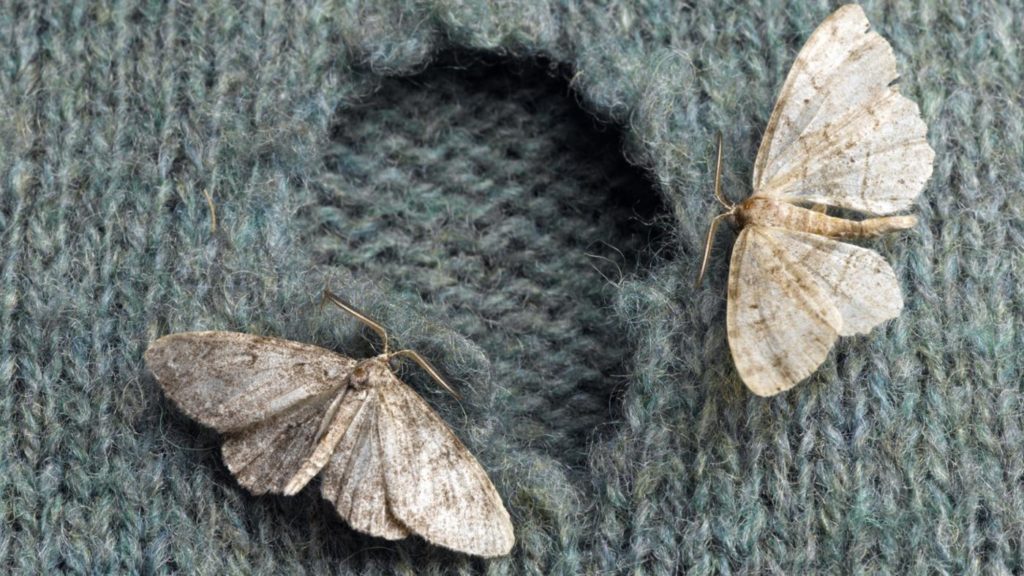While a moth infestation may not seem as problematic as rodents or cockroaches, moths can cause extensive damage. Moths do not spread disease or bite, but they will damage carpet, leather, fur, clothes, and fabric. It can be easy for a small moth problem to get out of hand and become a big problem if it isn’t addressed quickly. Here’s what you should know about moths in your home.

Signs You Have a Moth Infestation
There are several signs that indicate your home has a moth problem.
- Visible moths. If you see more than one moth flying in your home or resting on a surface, it may indicate an infestation.
- Cocoons, webbing, or droppings.
- Moth pupae in cabinets, walls, drawers, or food packages.
- Holes in clothing. The holes are irregular in shape with a size that depends on how long the larvae have been eating the protein-based fiber and whether the clothing had moisture or stains.
- Carpet damage. Moth damage is most obvious with soft pile rugs and carpets. You may see threadbare patches or even holes. Silk and wool rugs are prime targets, but moths may also target synthetic fibers. This damage is most apparent under furniture, along baseboards, and in rooms that are not used often.
Unfortunately, a moth infestation can go on for some time and cause extensive damage before the infestation is discovered. In Montreal, central heating allows moths to continue reproducing year round. If your home gets especially cold, it will probably only slow the moth’s lifecycle stages yet extend the larvae stage.
Pheromone Traps
Pheromone traps are not used to control moth infestations, but they can be used to determine the extent of the problem and whether pest control methods are successful. These glue traps have a pheromone lure that attracts adult male moths. Sometimes moth traps can help break a breeding cycle by attracting and trapping male moths, although this is not their primary purpose.
Common Types of Moths
There are two primary types of moths that infest Montreal homes. Each moth can be identified by its unique appearance and behavior. You can also tell the difference based on the moth’s location and food source.
Clothes Moths
Clothes moths primarily target fabric, including wool, fur, silk, carpet, leather, and, as the name implies, clothing. They’re fairly small at just 2.5 to 5cm with silvery brown-coloured wings. It can be easy for a clothes moth problem to get out of hand. One female may lay up to 100 tiny eggs over just 3 weeks. Clothes moths avoid light and are usually found in dark areas like closets and basements. You are most likely to find the moths hiding in the folds of your clothing or dark corners.
It’s the larvae, not the adult moths, that are responsible for damaging fabric. These moths prefer animal-based fabric like wool, leather, and silk, but they will still feed on almost any fabric. Clothes moths can eat stuffed animals, pillows, comforters, sweaters, carpet, and sometimes synthetic fibers.
Indian Meal Moth
This moth is about 5/8″ long with wings that are reddish-copper on two-thirds. Also known as a pantry moth or grain moth, these pests can quickly infest food. Grain moths primary affect food products, not fabric. In most cases, grain moths enter your home by bringing in a food product that’s infested. This commonly happens when immature stages of the moth crawl into packages. Grain moths are most active at night.
Keeping Moths Away
There are several steps you can take to help get rid of moths and keep them away.
- Wash curtains, towels, and fabrics in affected areas.
- Clean and wash affected drawers, cupboards, dressers, and wardrobes, including tiny crevices where eggs can hide.
- Clean out bags, suitcases, and any containers that may hide eggs and larvae.
- Change your vacuum bags often to ensure all eggs and larvae are removed.
- Mothballs can help deter clothes moths, but they can leave an odor that requires dry cleaning to remove.
Professional Moth Pest Control
We offer a range of solutions to treat moth infestations and solve the problem for good. Our eco-friendly pest control solutions can eliminate moths in all stages, including eggs and larvae. If you have an infestation on delicate items like lace that cannot be laundered, professional pest control may be the only option.
For Indian meal moths, we may recommend non-chemical pest control such as freezing, vacuuming, proper food storage, and possibly spraying. Liquid sprays and dusts may be used to control clothes moths. To monitor the infestation and ensure the moth problem does not continue, we will apply pheromone traps.
If you believe you have a moth infestation in your home, contact our Montreal pest control experts right away to schedule an inspection and develop a custom plan to get rid of the problem for good.